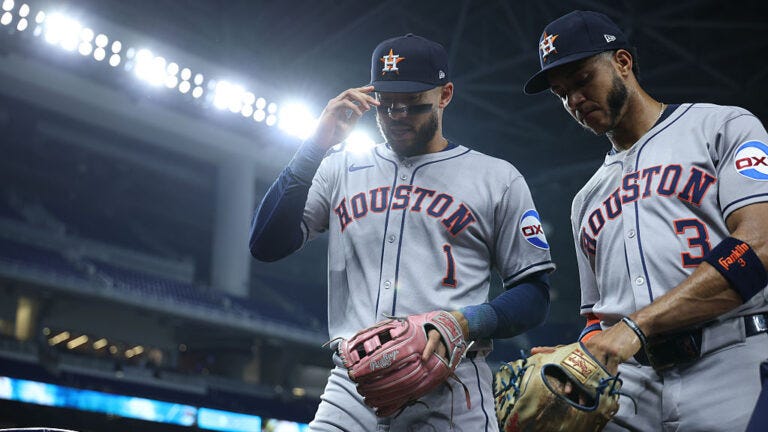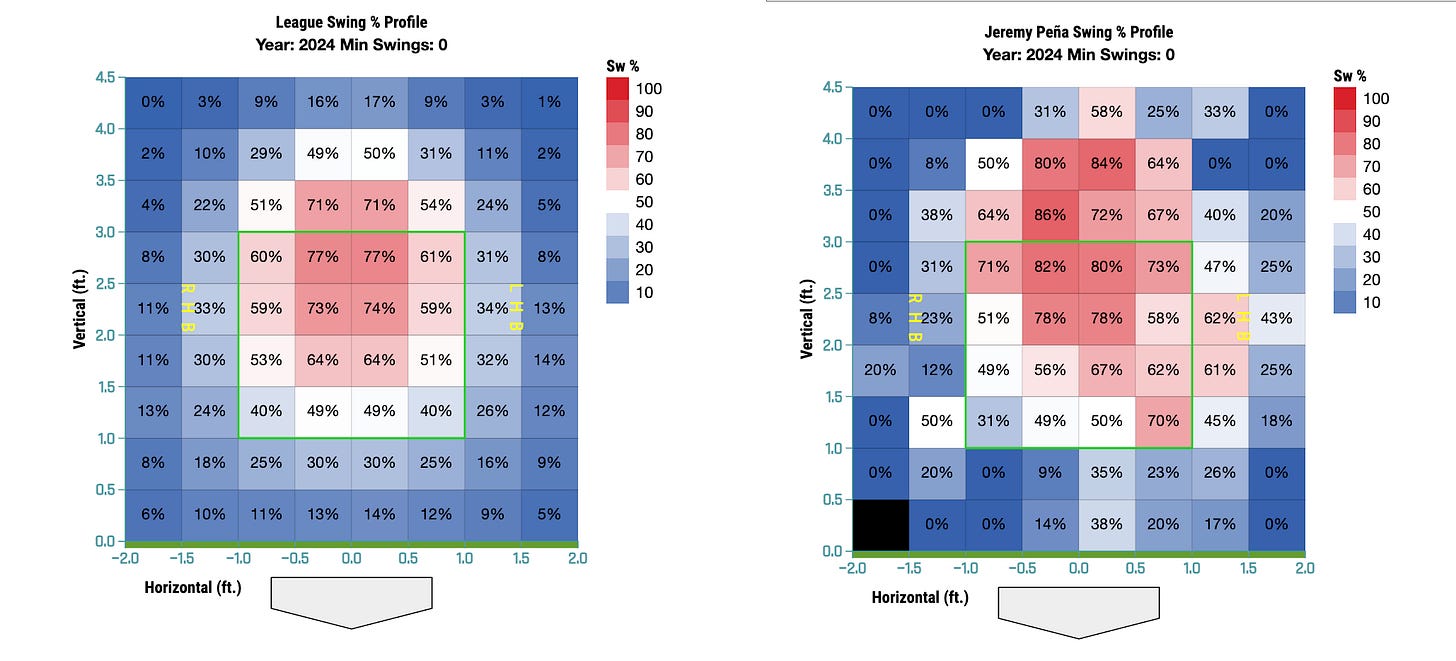The Jeremy Peña Conundrum: How One Season Changed Everything
A breakout year and Scott Boras may have sealed the shortstop's fate in Houston
This was supposed to be Jeremy Peña’s year. After three seasons of being a solid but unspectacular shortstop, the 27-year-old had finally unlocked his offensive potential in 2025. He was hitting .322/.380/.493 through the All-Star break, receiving MVP votes, and looking like the franchise cornerstone the Houston Astros always hoped he’d become.
Then being a player for the 2025 Houston Astros happened, as it did to Isaac Parades, Yordan Alvaraz and 28 others.
A rib injury in late June cost him 27 games during the Astros’ most critical stretch. While recovering, he made a decision that fundamentally altered his relationship with Houston. He hired Scott Boras as his agent, effectively killing extension talks that had been progressing toward a five-year, $105 million deal.
Now, as the Astros miss the playoffs for the first time since 2016, Peña’s breakout season has become one hell of a mess. And honestly? It didn’t have to be this way.
Working with Correa
The transformation began last winter in Houston, where Peña worked out alongside Carlos Correa. The former Astros shortstop, still with Minnesota at the time, had insights about what was holding Peña back.
“I just kind of picked his brain on what worked for him,” Peña said. “He had a great season last year. He was hitting everything hard.”
Working with Correa, Peña overhauled his problematic stance. His body had been rocking back and forth, causing his head to move, and his hands were constantly in motion.
The mechanical changes were comprehensive. Peña tightened his stance, eliminated excess movement, and focused on plate discipline. Most importantly, Correa taught him to be “quick to the baseball on a swing while remaining aggressive.”
Results were immediate. Against breaking pitches, his career-long weakness, Peña improved from .233 with a 37.8% whiff rate (2022-24) to .313 with a 33.2% whiff rate in 2025. His ability to pull the ball in the air jumped to 20.1%, a career high.
You could see it in the numbers, sure, but you could also see it in his at bats. Peña was laying off pitches used to tie him up, turning on fastballs he used to foul off weakly.
The heat map comparison tells the whole story. Look at Peña’s 2024 swing profile compared to league average; he’s swinging at strikes in the zone at rates of 78-86%, more aggressive than the 77% league average. That’s Correa’s teaching about being “quick to the baseball” on hittable pitches.
But the improvement shows outside the zone too. Peña swings less than league average on pitches away from the plate, particularly those low offerings that used to get him in trouble. His chase rate dropped to 34.5%, still high, but the best of his career. You can see it clearly - more swings in the strike zone, fewer chases on bad pitches, including his early nemesis, the slider.
Lost in all the offensive improvements was that Peña was also having his best defensive season. He ranked in the top 10% in Outs Above Average according to Baseball Savant. Only Masyn Winn, Nick Allen, Carlos Correa, and Bobby Witt Jr. posted better OAA numbers among shortstops.
Which makes what happened next even more frustrating.
The injury
Just as Peña was establishing himself as a legitimate All-Star, disaster struck. On June 27, he was hit by an 89.0 mph changeup from Cubs pitcher Cade Horton, fracturing a rib on his left side.
The timing couldn’t have been worse. Peña was forced to miss the All-Star Game he had earned and spent 27 games on the injured list during Houston’s most critical stretch. When he returned on August 1, the momentum was gone.
The cruel part? Carlos Correa, the man who had helped unlock Peña’s potential, was traded back to Houston in late July while Peña was still recovering. The reunion both players had discussed during their winter workouts was delayed by the very injury that occurred during Peña’s breakout.
2025 has been funny and cruel like that.
Enter Scott Boras
While on the injured list, Peña made a decision that sent shockwaves through the Astros organization: he fired his agents at Beverly Hills Sports Council and hired Scott Boras. The timing here was particularly stunning because it came in the middle of what multiple reports described as “serious” extension talks. The Astros had been discussing a five-year deal worth approximately $105 million with Peña’s previous representation.
His teammate Mauricio Dubón had been telling anyone who would listen: “He’s a $300 million player. He’s been showing it.”
Maybe Dubón was right. Maybe Peña was betting that his breakout season would continue and that free agency in 2028 would yield far more than Houston’s offer. But that’s a hell of a gamble when you’re coming off an injury.
The money gets complicated
The hiring of Boras fundamentally changed everything. Recent shortstop contracts have exploded well beyond what the Astros typically spend. Trea Turner signed for $27.3 million AAV with Philadelphia in 2023. Willy Adames got $26 million AAV from San Francisco in 2024.
For Peña to sign an extension now, he would likely command $25-27 million AAV over 6-7 years. A total package worth $160-180 million. That’s nearly double what Houston was reportedly offering and would represent the largest contract in franchise history.
The Astros’ biggest deal to date remains Jose Altuve’s $157 million extension. You get the sense that ownership isn’t eager to blow past that number, even for a homegrown star entering his prime.
September struggles
As if things weren’t messy enough, Peña suffered another setback in late September. An oblique strain sidelined him during the Astros’ desperate playoff push, costing him crucial games as Houston fought for their postseason lives.
The injury occurred on September 20, just as the Astros were battling for their eighth consecutive playoff appearance. Instead of being the catalyst for another October run, Peña was watching from the sidelines as his team’s season fell apart.
You have to wonder if he was pressing, trying to do too much to prove his worth after the Boras signing created all that noise.
What happens now?
Peña still has two years of team control remaining, so there’s time to figure this out. But once Boras is involved, extension talks tend to stay dead.
For Peña, it’s simple: stay healthy for two more seasons and potentially earn $200-300 million in free agency versus accepting an extension that might not even be offered again.
For the Astros, they’re staring at losing another homegrown star to free agency. Carlos Correa, George Springer, Alex Bregman. The pattern keeps repeating itself.
The 2025 season was supposed to be Jeremy Peña’s arrival as a franchise player. Instead, it might be the year that set his departure in motion.
With the CBA coming up in 2027, it’s going to be a very interesting offseason in Houston. It is also another frustrating chapter in 2025…the season of what could have been.
Note: As I write these pieces every day, something changes. Right before I started writing this, Jake Meyers joined him on the IL.



